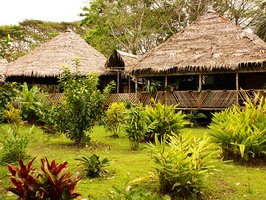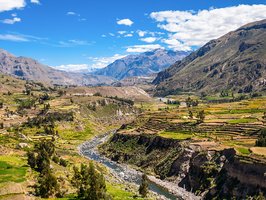Here you can find answers to all the important questions about our travel country Peru. If you want to learn about the entry requirements, customs or information about weather, locals or cuisine. We listed everything for you to make sure, you can start your adventure without any worries.
Entry & Exit
Citizens of Canada and the UK need a passport, that is valid for another 6 months after your planned departure. A tourist visa is not require for stays up to 183 days.
Make sure you get an entry stamp at your arrival. If you don't get one, you need to apply for an entry stamp ath the neares immigration office (provide your passport, evidence of your entry to Peru, exit stamp from the last country you've visited). If you can't provide theses, you need to apply for an exit or expulsion at the Immigration Office in Lima.
For the custom regulations at your reentry to Canada/UK please see special regulations at Global Affairs Canada or the Foreign and Commonwealth Office.
Vaccinations are not obligatory at the moment. It's recommended to have all standard vaccination.
For travels to Yellow Fever regions (especially Amazon region) a vaccination is highly recommended. For further travels into other countries you might need a certificate.
Zika virus
The amount of mosquitos, that are transmitting the Zika virus increased in the past years for all regions under 2.000m of altitude. The symptoms are similar to Dengue fever and is especially dangerous for unborn children. Pregnant women are disadvised to travel to endangered regions. A sexual transmission is not excluded.
Chikungunya
Since 2014 there are cases of infections in Peru. The virus is transmitted by the diurnal Aedes mosquito. The symptoms are similar to the Dengue fever.
Leishmaniose
Leishmaniose is a parasite disease, which is transmitted by sandflies. There are different variations, where the parasite is attacking the skin and organs.
Malaria
The nocturnal Anopheles-mosquito is transmitting Malaria. The disease can break out weeks or months after the stay in an endangered region. Regions above 2.000 m have a lower risk of infection, especially the rainforest and the Sierra Alte in the regions Ayacucho, Junín, Loreto, Madre de Dios, San Martín, Puerto Maldonado and Iquito.
The regions Lima, Cuzco, Mach Picchu, the Andes highlands, the coast of Lima, Ica and Nazca are declared Malaria free.
Diarrheal diseases
Diarrheal diseases are mostly caused by contaminated water or food. You should not dring tab water. Caution: avoid buying water on the streets because bottles are ofted refilled. If you buy water, take care that the bottle is closed and sealed. Food should alway be cooked or peeled. Make sure flies are not getting to your food and wash your hands as often as possible.
Altitude Sickness ("Soroche")
Soroche is a sickness, that is popular after longer stays in regions above 2.500 m. Symptoms are dizziness, headache, vomiting, insomnia and (increasing) breathlessness. Avoid fast ascendings. If you are suffering from Soroche you should descend to altitude under 2000 m, if symptoms are not getting better after one night. Not only mountaineers are affected but also people, which used a direct flight to Puno or Cuzco. With Coca tea, symptoms can be improved but this is not a safe protection.
In Lima you can find private hospitals, that can match international standards. Public medical centers are mostly not as good. Especially in rural areas standards are not satisfying.
Travel Facts for Peru
The climate is Peru is very diverse. The climate at the coasts is very stable and mostly dry. In the north you can find a rather tropical climate. Depending on which locations you want to visit, you should be aware of the summer / rainy season in the rainforest regeions or hike in the Andes.
October to May are the spring and summer season for the coastal regions. Lima is surrounded by desert. The water supply is highly dependable on the rainfall in the Andes. In the winter (May to September) a fog is laying of Lima - "la garua" - and the humidity is raising up to 90%. The temperature can fall down to 12°C, mostly accompanied by rainfall.
In comparision to Lima May to October is the best time to travel to the highlands of the Andes, due to less rainfall. If you want to visit Cuzco and Machu Picchu, keep in mind that heavy rainfall is common from December to May. Sometimes these rainfalls are causing the closing of the Inka-Trail and the track of the trains to Machu Picchu are impassable.
For the rainforest (Peruvian lowlands) the dry season is from April to October and temperatures are raising up to 35°C. Escpecially in March you can expect heavy rainfalls. In the southern jungle you can be confronted with cold winds - "friaje" - between May and August and the tempartures are falling to 10°C. In the north of the rainforest temperatures are more stable.
Peru is falling into the UTC -5 time zone and does not use Daylight Saving Time clock changes.
The official currency of Peru is, since 2015, the Sol (Pl. Soles). 1 Sol is devided into 100 céntimos. There are 5, 10, 20 and 50 centimos, 1,2 and 5 soles coinst and 10, 20, 50, 100 and 200 soles banknotes.
Cash can be withdrawn with credit card from ATMs, either in US Dollar or Soles. Debit cards are not very common. In many locations you can pay with US Dollar.
Exchange rates1 CAD = 2,54 Soles
1 £ = 4,14 Soles
Calle Bolognesi 228, Miraflores, Lima 15074, Peru
Tel.: +51 1 319 3200
Internet: www.peru.gc.ca British Embassy (Lima)
Torre Parque Mar (22nd Floor), Avenida José Larco 1301, Miraflores
Tel.: +51 1 617 3000
Internet: www.gov.uk/contact-consulate-lima Important numbers:
Tourist police North Lima: +51 01 423 3500
Tourist police South LIma: +51 01 460 0844
Iperú, Tourist consulting (24h): +51 01 574 8000 Police: 105
Ambulance: 106
Firefighters: 116
People & Landscape
Peru has 31 million inhabitants. About 9,7 million of them are living in the capital Lima. This also includes the city Callao (about 1 million inhabitants) because the cities are merging into each other. Politically Callao is independent from Lima. Since March 2018 Martin Vizcarra is the president of Peru.
The populations consists of 47% indigenous, 37% Mestizos, 13% Europeans and 3% Africans and Asians.
Beside Spanish you can also find some indigenous languages as official languages. More than 85% of the population are native Spanish speaker. Quechua, which has 32 different dialects only in Peru, is the native language of 13% of the population.
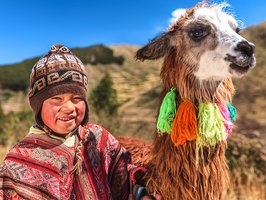
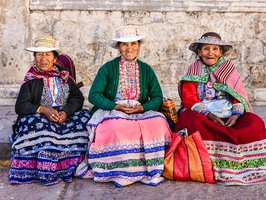
81% of the population claims to be Catholic, about 12,5% are Protestants, 3,3% don't name any religion. In the rural areas you can find more of the Andean religions, which is dominated buy opposed appreciation, help for people in need and respect for nature. Pachamama - the Quechuan word for mother earth - a goddess from Inkan culture, is still worshipped today. Pachamama is often equated with the Virgen de la Candelaria.
The outlast of rituals and architectures of ancient tribes, the mixture after the Spanish Conquista and the waves of mirgration from Asia, Africa and European countries are making Perus culture very diverse. Not only in architecture but also in cuisine, music, dance and the ideology are showing this. Especially in bigger cities like Lima, Cuzco, Arequipa or Cajamarca the baroque style of the colonial time is showing. The music styles and instruments are varying in every region: Cumbia (Amazon region), Huayno (Andes) and Marinera (coast/Lima) are the most popular ones. You can also find differences in the clothing: While you can find western styles in cities, in the Andean regions women are wearing different skirts above each other (polleras) and scarfs (fajas) in different colors, which are also used to carry food or children.
The Peruvian landscape is very diverse, which is also impacting the flora and fauna. The country can be devided into three geographical regions: the coastal area (Costa), the Andes and the Andean highlands (Sierra) and the rainsforest (Selva).
The whole coastal area is almost completely covered in desert. You can discover different seals, penguins, whales and dolphins.
In the Sierra the Cordilleras are determining the climate: there is a subtropical moutainous climate. Above heights of 5.000 m everything is icy but due to climate changes there is a significant decrease of ice. There are 20 mountain ranges and 30 peaks above 6.000 m, that are always covered in snow. In the highlands you can find alpacas and lamas and their wild relatives the guanacos ans vicuñas. You can also observe the Andean condors flying over the canyons. With a wing-spread of up to 3,20 m, it is the biggest bird of prey in the world.
If people are talking about the rainforest, they are distincting the Selva Alta from the Selva Baja. The Selva Baja is the lower Amazon region, that's also including the regions Ucayalí and the western part of Madre de Dios. The higher rainsforest (Selva Alta) is located on the east side of the Andes and can get up to 3.600m. In the Selva you can find 260 species of amphibians, 290 mammals and 7300 plants on a area of 282880 km².
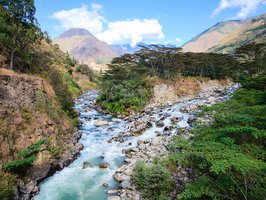
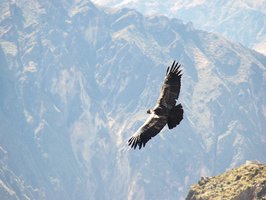
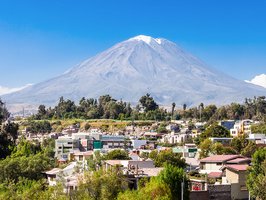
Peru has an excellent cuisine. Some of the best cooks in the world are coming from Peru. Three of the Top 50 world best restaurants are located in Lima. The variety of dishes - about 490 different ones - from the different regions are taking the culinary experience to the next level. The cuisine is devided into the cocina marina, criolla, andina and de la selva.
Especially on the coast but also at the Titicaca Lake and the rivers of the rainforest you can find a lot of dishes with fish and seafood. The popular Ceviche is for most people a little strange at first. It consists of raw fish in lime juice, aji (a kind of Chili) and onions. You eat it with Camote (sweet potato) and Choclo (a type of corn).
An example for the Creole cuisine is the aji de gallina. The dish is made from chicken in a viscid sauce and is served with rice and potatos. Many more dishes are cooked with meat. There are also 3.000 different types of potatos. If you don't like to eat entrails you should avoid the dish Mondonguito.
The Andean cuisine consisted originally of less meat and more potatos, corn and root vegetables. Today you can also find a lot of beef, mutton and pork. In very high areas also meat from lamas and alpacas. The cuy - the guinea pig - is usually from the Andes and is part of the lifestock. It's as common in Peru as chicken for us.
The dishes from the rainforest are, due to the geography, different. Huanganda - a type of wild pig - but also bugs and tapirs are part of the cuisine. With the meat you eat Yuca (manioc) or bananas.
There are also many different sweet dishes in Peru: Mazamorra Morada (made from violet corn) is often served with rice pudding, Suspiro Limeño (sweet dish made from suger, egg yolk and milk) or Picarones (fried, mostly from flour and pumpkin, served with honey).
There are also very unique beverages in Peru. The Chicha Morada is made from violet corn, pineapple and cinnamon. The bright yellow Inca Kola is a soft drink that's more popular than Coca Cola. At many little stands and small restaurant you can enjoy freshly served juices in all variations. The most popular alcoholic drink is the Pisco, made from grapes. You can drink it pure but it's also used for longdrinks and cocktails.
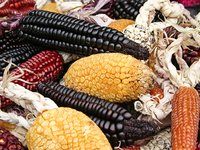
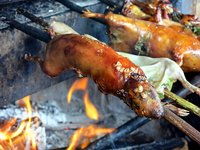

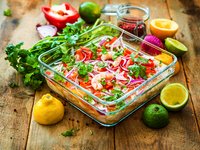
If you are well informed about Peru now, have a look at our Trips to Peru or contact our team.
Current Situation
Please keep in mind, that the security situation at place can change at any time. Therefore we recommend to have a look at the current safety information at Global Affairs Canada or Foreign and Commonwealth Office.
Exclusion of Liability
Those who choose to travel do so entirely at their own risk. SC Travel Adventures endeavours to inform tourists of the risks involved with travelling but cannot be held liable for any events which occur outside of their direct control. Tourists are advised to avoid areas considered unsafe, remain vigilant and cautious at all times throughout their stay, and heed the advice of local authorities.

